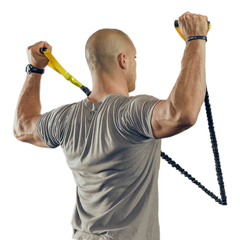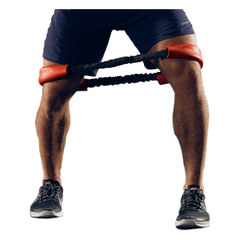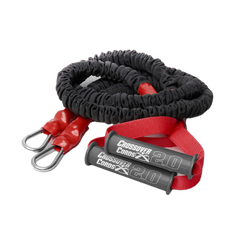A good handshake says a lot. It shows confidence, binds an honest contract, and makes a strong statement about your health and function as a human—because in life, we grip everything.
We pick up our kids, carry groceries, and open jars. And among athletics, we lift weights, throw balls, and grip bats, clubs, and rackets.
Although, as you’ll learn, the grip does much more than solidify a hold on things!
In this article, we’ll explore the importance of grip when it comes to strength and rehabilitation and explain why you should work your grip for stronger shoulders.
The Ignition Switch
In the early 1900s, Sir Charles Scott Sherrington, a Nobel Prize-winning physiologist, discovered many complex interactions between the nervous system and the muscles.
One of them is called muscle irradiation, which describes how tension in one muscle spreads and increases tension in adjacent muscles.
This is particularly true for the upper extremity with an “irradiation” of muscle activity beginning with the grip. As you grip an object, it activates the stabilizers of the shoulder and trunk.
This anticipatory stability readies the body to effectively manipulate the load. Thus your hands aren’t just claws for holding onto things but also an ignition switch that prepares the body to go (ref, ref).
Connecting the Chain
Phrases like “break the bar” or “screw your feet down” are common coaching cues before big lifts. This generates hip and shoulder rotation for stable positions ready to move heavy loads.
But to generate torque, you need a strong connection point.
If you opt for a weak finger hold, you’ll notice you can’t lock the shoulders either. This limits performance and results in compensations at the elbow, shoulder, or spine.
Grip for Shoulder Strength
For healthy and pain-free shoulders, the rotator cuff is a huge part of the equation.
We cover the importance of the rotator cuff here: How to Build Rotator Cuff Strength for Strong and Painfree Shoulders, but the quick summary is that the rotator cuff balances the forces around the shoulder to keep the arm correctly positioned in the socket.

Many overuse injuries and cases of shoulder pain happen when the rotator cuff doesn’t stabilize the shoulder very well against the opposing pull of the deltoid.
So the cuff needs some training to adequately stabilize the shoulder. But too often, rotator cuff training focuses on the isolated function of each muscle by doing light shoulder rotations and shoulder lifts with super light weights.
In reality, this is not how the shoulder functions.
There are situations in the rehabilitation world where these basic isolated movements and neuromuscular firing tasks need to be trained.
But once you can effectively engage the right muscles, the focus should shift to more compound movements that better mimic life and sport.
Which is further facilitated by gripping objects to lift.
The research shows that even a slight grip can significantly increase rotator cuff (supraspinatus and infraspinatus) activity, which improves the ratio of muscle forces between the rotator cuff and deltoid (ref, ref).
This helps reduce the risk of impingement and sets up the shoulder for performance.
Make Big Gains With A Strong Grip
Lift, carry, hang, and climb…that’s the best way to build strength, along with strong hands to support it. But here are a couple of specifics to put into practice…
1. Hold Onto Things
Again, we talked a ton about rotator cuff training here:
How to Build Rotator Cuff Strength for Strong and Painfree Shoulders
In this article, we pointed out that the best way to strengthen the rotator cuff was to do things like presses and pull-ups.
But to go along with that, make sure you’ve got a strong hold on the implement in your palm. This will improve the rotator cuff engagement and generate better torque at the shoulder joint.
And for things like Crossover Symmetry, make sure you’ve got the handle of the band in the palm rather than in the fingers, and stop wasting your time with bands that attach to your wrist. I’ll make the point again, use a firm grip for stronger shoulders through increased activation and better movement at the shoulder joint.
2. Grip Work For Shoulder Work
There is a strong correlation between a strong grip for better shoulders (ref).
Partly because lifting weights improves both the grip and rotator cuff, but there’s also evidence to show that grip exercises provide a training effect for the shoulder as well (ref).
If you’re struggling with some shoulder pain, grip-intensive exercises like farmer carries and deadlifts can provide a training effect for the shoulder with minimal risk of furthering any irritation.
You can also use this evidence to close out your shoulder training days. Throw some carries and hangs on the tail end of your shoulder days to increase workloads without piling more repetitions on the joint.
Get a grip on things…
Irradiation of the upper extremity from gripping a handle or weight is a natural part of movement and is necessary for proper shoulder function.
For those reasons, if you want to improve the capacity of your rotator cuff and shoulder complex, exercises that use a grip are better options for strength, function, and overall shoulder health.
 Shoulder Packages
Shoulder Packages
 Hip & Core Package
Hip & Core Package
 NEW - Crossover TORQ
NEW - Crossover TORQ
 Bundles
Bundles
 Accessories
Accessories

























